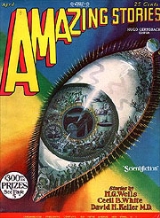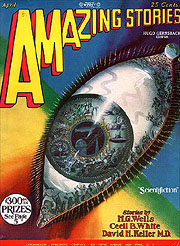
Clare Winger Harris
Encyclopedia

Science fiction
Science fiction is a genre of fiction dealing with imaginary but more or less plausible content such as future settings, futuristic science and technology, space travel, aliens, and paranormal abilities...
writer whose short stories
Short Stories
Short Stories may refer to:*A plural for Short story*Short Stories , an American pulp magazine published from 1890-1959*Short Stories, a 1954 collection by O. E...
were published during the 1920s. She is credited as the first woman to publish stories under her own name in science fiction magazine
Science fiction magazine
A science fiction magazine is a publication that offers primarily science fiction, either in a hard copy periodical format or on the Internet....
s. Her stories often dealt with characters on the "borders of humanity" such as cyborgs.
Harris began publishing in 1926, and soon became well liked by readers. She sold a total of eleven stories, which were collected in 1947 as Away From the Here and Now. Her gender was a surprise to Gernsback, the editor who first bought her work, as she was the first woman to publish science fiction stories under her own name. Her stories, which often feature strong female characters, have been occasionally reprinted and have received some positive critical response, including a recognition of her pioneering role as a woman writer in a male-dominated field.
Life
Clare Winger was born on January 18, 1891, in Freeport, IllinoisFreeport, Illinois
Freeport is a city in and the county seat of Stephenson County, Illinois, United States. The population was 26,443 at the 2000 census. The mayor of Freeport is George W...
and later attended Smith College
Smith College
Smith College is a private, independent women's liberal arts college located in Northampton, Massachusetts. It is the largest member of the Seven Sisters...
in Massachusetts
Massachusetts
The Commonwealth of Massachusetts is a state in the New England region of the northeastern United States of America. It is bordered by Rhode Island and Connecticut to the south, New York to the west, and Vermont and New Hampshire to the north; at its east lies the Atlantic Ocean. As of the 2010...
. In 1912 she married Frank Clyde Harris. Her husband was an architect
Architect
An architect is a person trained in the planning, design and oversight of the construction of buildings. To practice architecture means to offer or render services in connection with the design and construction of a building, or group of buildings and the space within the site surrounding the...
and engineer
Engineer
An engineer is a professional practitioner of engineering, concerned with applying scientific knowledge, mathematics and ingenuity to develop solutions for technical problems. Engineers design materials, structures, machines and systems while considering the limitations imposed by practicality,...
who served in World War I
World War I
World War I , which was predominantly called the World War or the Great War from its occurrence until 1939, and the First World War or World War I thereafter, was a major war centred in Europe that began on 28 July 1914 and lasted until 11 November 1918...
and was chief engineer with the Loudon Machinery Company in Iowa and one of the organizers of the American Monorail Company of Cleveland, Ohio
Cleveland, Ohio
Cleveland is a city in the U.S. state of Ohio and is the county seat of Cuyahoga County, the most populous county in the state. The city is located in northeastern Ohio on the southern shore of Lake Erie, approximately west of the Pennsylvania border...
.
Harris gave birth to three sons (Clyde Winger, born 1915; Donald Stover, born 1916; and Lynn Thackrey, born 1918). She died in Pasadena, California
Pasadena, California
Pasadena is a city in Los Angeles County, California, United States. Although famous for hosting the annual Rose Bowl football game and Tournament of Roses Parade, Pasadena is the home to many scientific and cultural institutions, including the California Institute of Technology , the Jet...
in 1968.
Harris wrote her most acclaimed works during the 1920s. In 1930, she stopped writing to raise and educate her children.
Writing career
Harris published her first short story, "The Runaway World," in the July 1926 issue of Weird TalesWeird Tales
Weird Tales is an American fantasy and horror fiction pulp magazine first published in March 1923. It ceased its original run in September 1954, after 279 issues, but has since been revived. The magazine was set up in Chicago by J. C. Henneberger, an ex-journalist with a taste for the macabre....
. In December of that year, she submitted a story for a contest being run by Amazing Stories
Amazing Stories
Amazing Stories was an American science fiction magazine launched in April 1926 by Hugo Gernsback's Experimenter Publishing. It was the first magazine devoted solely to science fiction...
editor Hugo Gernsback
Hugo Gernsback
Hugo Gernsback , born Hugo Gernsbacher, was a Luxembourgian American inventor, writer, editor, and magazine publisher, best remembered for publications that included the first science fiction magazine. His contributions to the genre as publisher were so significant that, along with H. G...
. Harris's story, "The Fate of the Poseidonia" (a space opera
Space opera
Space opera is a subgenre of science fiction that emphasizes romantic, often melodramatic adventure, set mainly or entirely in outer space, generally involving conflict between opponents possessing advanced technologies and abilities. The term has no relation to music and it is analogous to "soap...
about Martians who steal earth's water, placed third. Harris soon became one of Gernback's most popular writers.
Harris eventually published eleven short stories in pulp magazines, most of them in Amazing Stories (although she also published in other places such as Science Wonder Quarterly).
In 1947 Harris's short stories were collected under the title Away from the Here and Now. Her stories have also been reprinted in anthologies such as Daughters of Earth: Feminist Science Fiction in the 20th Century (with a critical essay), Sci-Fi Womanthology, Amazing Science Fiction Anthology: The Wonder Years 1926-1935, and Gosh Wow! Sense of Wonder Science Fiction. She wrote one novel
Novel
A novel is a book of long narrative in literary prose. The genre has historical roots both in the fields of the medieval and early modern romance and in the tradition of the novella. The latter supplied the present generic term in the late 18th century....
, Persephone of Eleusis: A Romance of Ancient Greece (1923).
Harris also wrote one of the first attempts to classify science fiction when, in the August 1931 issue of Wonder Stories
Wonder Stories
Wonder Stories was an early American science fiction magazine which was published under several titles from 1929 to 1955. It was founded by Hugo Gernsback in 1929 after he had lost control of his first science fiction magazine, Amazing Stories, when his media company Experimenter Publishing went...
, she listed 16 basic science fiction themes
Science fiction themes
-Overarching themes:*Cosmology*Creation of the Universe*The future *History **Alternate history **Historical cycles: history repeating itself **Scientific prediction of the future **Secret history*Language...
, including, "Interplanetary space travel," "Adventures on other worlds," and "The creation of synthetic life."
Critical view and influence
When Gernback published Harris's first short story in Amazing Stories, he praised her writing while also expressing amazement that a woman could write good scientifiction (as science fiction was then called), saying "That the third prize winner should prove to be a woman was one of the surprises of the contest, for, as a rule, women do not make good scientification writers, because their education and general tendencies on scientific matters are usually limited. But the exception, as usual, proves the rule, the exception in this case being extraordinarily impressive."For many years Harris claimed to have been the first woman science-fiction writer in the United States. While this can be debated (since Gertrude Barrows Bennett
Gertrude Barrows Bennett
Gertrude Barrows Bennett was the first major female writer of fantasy and science fiction in the United States, publishing her stories under the pseudonym Francis Stevens. Bennett wrote a number of highly acclaimed fantasies between 1917 and 1923 and has been called "the woman who invented dark...
, writing under the pseudonym Francis Stevens, published science fiction stories as early as 1917), Harris is recognized as the first woman to publish stories in science fiction magazines under her own name.
Even though Harris published only a handful of stories, almost all of them have been reprinted over the years. Of these, "The Miracle of the Lily" has been reprinted the most and praised by many critics, with Richard Lupoff saying the story would have "won the Hugo Award
Hugo Award
The Hugo Awards are given annually for the best science fiction or fantasy works and achievements of the previous year. The award is named after Hugo Gernsback, the founder of the pioneering science fiction magazine Amazing Stories, and was officially named the Science Fiction Achievement Awards...
for best short story, if the award had existed then." Lupoff also wrote that "[w]hile today's reader may find her prose creaky and old-fashioned, the stories positively teem with still-fresh and provocative ideas.
"The Fate of the Poseidonia" has also been reprinted a number of times and is credited as an early example of a science fiction story with a heroic female lead character. Other of Harris's stories are also noted for featuring strong female characters, such as Sylvia, the airplane pilot and mechanic in "The Ape Cycle" (1930). Harris also wrote one story untilizing a female point of view (in 1928's "The Fifth Dimension").
Because Harris was the first woman published in science fiction magazines, and because of her embrace of female characters and themes, she has been recognized in recent years as a pioneer of women's and feminist science fiction.
Collections
- Away from the Here and Now: Stories in Pseudo-Science (Philadelphia: Dorrance, 1947)
Short stories
- "A Runaway World" (Weird Tales, July 1926)
- "The Fate of the Poseidonia" (Amazing Stories, June 1927)
- "A Certain Soldier" (Weird Tales, November 1927)
- "The Fifth Dimension" (Amazing Stories, December 1928)
- "The Menace From Mars" (Amazing Stories, October 1928)
- "The Miracle of the Lily" (Amazing Stories, April 1928)
- "The Artificial Man" (Science Wonder Quarterly, Fall 1929)
- "A Baby on Neptune" with Miles J. BreuerMiles J. BreuerMiles John Breuer was an American physician and science fiction writer. He was part of the first generation of writers to appear regularly in the pulp science fiction magazines, publishing his first story, "The Man with the Strange Head", in the January 1927 issue of Amazing Stories...
, M.D. (Amazing Stories, December 1929) - "The Diabolical Drug" (Amazing Stories, May 1929)
- "The Evolutionary Monstrosity" (Amazing Stories Quarterly, Winter 1929)
- "The Ape Cycle" (Science Wonder Quarterly, Spring 1930)
See also
- Women in science fiction
- Feminist science fictionFeminist science fictionFeminist science fiction is a sub-genre of science fiction which tends to deal with women's roles in society. Feminist science fiction poses questions about social issues such as how society constructs gender roles, the role reproduction plays in defining gender and the unequal political and...
- Women science fiction authors

